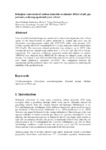Biological conversion of carbon monoxide to ethanol: Effect of pH, gas pressure, reducing agent and yeast extract

Use este enlace para citar
http://hdl.handle.net/2183/13694Coleccións
- Investigación (FCIE) [1227]
Metadatos
Mostrar o rexistro completo do ítemTítulo
Biological conversion of carbon monoxide to ethanol: Effect of pH, gas pressure, reducing agent and yeast extractData
2012-06Cita bibliográfica
Abubackar HN, Veiga MC, Kennes C. Biological conversion of carbon monoxide to ethanol: Effect of pH, gas pressure, reducing agent and yeast extract. Bioresour Technol. 2012;114:518-22.
Resumo
A two-level full factorial design was carried out in order to investigate the effect of four factors on the bioconversion of carbon monoxide to ethanol and acetic acid by Clostridium autoethanogenum: initial pH (4.75–5.75), initial total pressure (0.8–1.6 bar), cysteine–HCl•H2O concentration (0.5–1.2 g/L) and yeast extract concentration (0.6–1.6 g/L). The maximum ethanol production was enhanced up to 200% when lowering the pH and amount yeast extract from 5.75 to 4.75 g/L and 1.6 to 0.6 g/L, respectively. The regression coefficient, regression model and analysis of variance (ANOVA) were obtained using MINITAB 16 software for ethanol, acetic acid and biomass. For ethanol, it was observed that all the main effects and the interaction effects were found statistically significant (p < 0.05). The comparison between the experimental and the predicted values was found to be very satisfactory, indicating the suitability of the predicted model.
Palabras chave
CO–bioconversion
Clostridium autoethanogenum
Factorial design
Medium optimization
Waste gas
Clostridium autoethanogenum
Factorial design
Medium optimization
Waste gas





